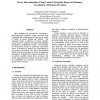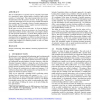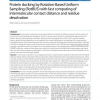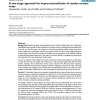44 search results - page 2 / 9 » Mining Residue Contacts in Proteins |
ISVD
2007
IEEE
14 years 1 months ago
2007
IEEE
Three strategies are presented for developing a knowledge-based statistical contact potential from computationally hydrated proteins that may be useful in studies of protein foldi...
KDD
2002
ACM
14 years 7 months ago
2002
ACM
The 3D conformation of a protein may be compactly represented in a symmetrical, square, boolean matrix of pairwise, inter-residue contacts, or "contact map". The contact...
ISMB
2000
13 years 8 months ago
2000
Knowing the number of residue contacts in a protein is crucial for deriving constraints useful in modeling protein folding, protein structure, and/or scoring remote homology searc...
BMCBI
2010
13 years 7 months ago
2010
Background: Protein-protein interactions are fundamental for the majority of cellular processes and their study is of enormous biotechnological and therapeutic interest. In recent...
BMCBI
2006
13 years 7 months ago
2006
Background: Protein topology representations such as residue contact maps are an important intermediate step towards ab initio prediction of protein structure. Although improvemen...




